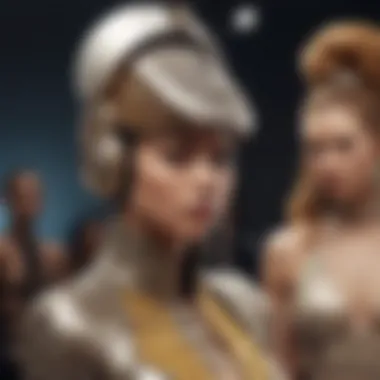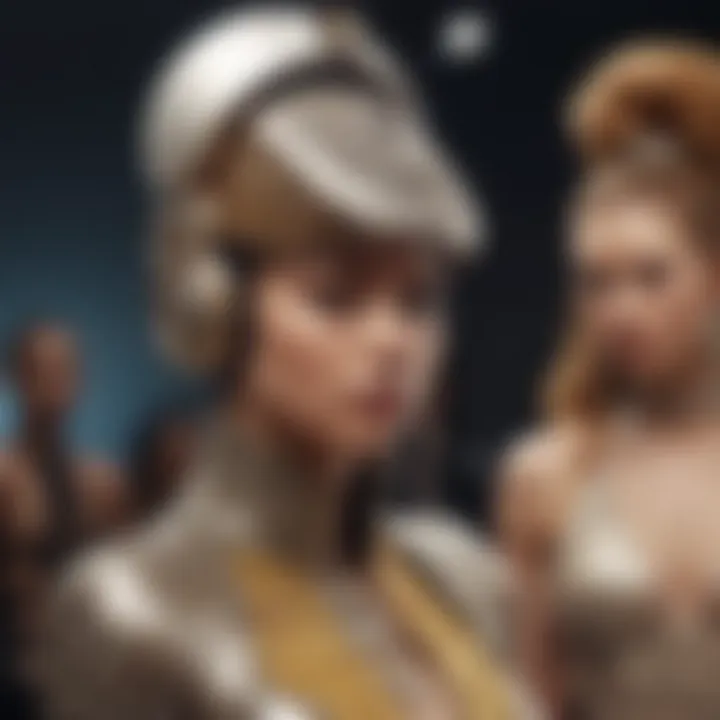The Evolution of Fashion at the Grammys


Intro
The Grammy Awards have long served not only as a celebration of music but also as a platform for artistic expression through fashion. From stunning gowns to avant-garde ensembles, the attire worn at this prestigious event reflects the changing times and cultural landscapes. Over the years, various styles have emerged, influenced by the music of the era and societal norms. This article seeks to dissect and analyze how the fashion seen at the Grammys resonates beyond the red carpet, showcasing the intricate relationship between music, culture, and style.
Fashion Trends
Fashion at the Grammys is often a reflection of broader trends in society. As artists push boundaries, they often serve as catalysts for change in the fashion world.
Seasonal Styles
Throughout the years, seasonal styles have played a significant role in shaping Grammy fashion. The events are often punctuated by notable trends:
- Glamorous Gowns: In earlier decades, you would see flowing and intricate designs dominating the red carpet.
- Sleek Silhouettes: As time progressed, many artists began to embrace more tailored looks, often accentuating the body shape with clean lines.
- Eclectic Choices: More recently, a fusion of styles has emerged, allowing for unique combinations of streetwear and high fashion.
These seasonal trends not only highlight the styles of the moment but also signal shifts in the cultural zeitgeist.
Influencer Inspirations
Social media has transformed how celebrities curate their public personas. Artists often draw inspiration from various influences:
- Fashion Designers: Collaborations with renowned designers can shape an artist's look for a particular event.
- Pop Culture: Icons of film and television impact what is deemed stylish, resulting in cross-pollination between different entertainment mediums.
- Social Movements: Activism and social justice issues have influenced many artists’ sartorial choices, making statements through their attire.
These influences contribute to an ever-evolving narrative of red carpet fashion, offering a glimpse into societal values and artistic expression.
Beauty Tips
While fashion takes center stage, beauty also plays a crucial role in completing the overall look of each artist on the Grammy red carpet.
Skincare Routines
A good skincare routine can enhance any look and has become essential for many celebrities. Successful routines often focus on:
- Hydration: Keeping the skin hydrated is crucial for that coveted red carpet glow.
- Pre-Event Treatments: Many artists opt for facials or skincare treatments leading up to the event.
Makeup Techniques
Makeup is a powerful tool for self-expression. Techniques can vary widely, but common trends include:
- Bold Lips: A striking lip color can make a memorable statement on the red carpet.
- Defined Features: Contouring and highlighting have become staples to accentuate facial features remarkably.
Product Reviews
An examination of Grammy fashion wouldn't be complete without discussing the products that enable these stunning looks.
Trending Products
Several products have gained popularity among celebrities for various reasons:
- High-Quality Foundations: Brands like Fenty Beauty and Estée Lauder prepare skin for the spotlight.
- Finishing Sprays: Products like Urban Decay's All Nighter keep makeup fresh throughout the night.
Comparison Guides
Choosing the right products is imperative. Comparison of best-selling items can provide insight into what works best for different skin types and preferences. Articles often delve into effectiveness, price points, and user reviews.
"Fashion is a form of self-expression that reflects the cultural milestone of its time."
As we delve further into the evolution of fashion at the Grammys, we will unpack iconic styles and the messages they convey in the broader context of culture and artistry.
Historical Overview of the Grammys


The Grammy Awards stand as a significant cultural artifact within the music industry. Understanding the historical context of these awards offers critical insight into their evolution and influence on fashion trends seen on the red carpet. This section highlights the inception of the Grammys and examines the significance of the red carpet as a platform for artistic expression.
Origins of the Grammy Awards
The Grammy Awards were established in 1959 by the National Academy of Recording Arts and Sciences (NARAS). They were created to honor outstanding achievement in the recording industry and to recognize diverse musical genres. Initially, the ceremony aimed to celebrate artists who had historically been overlooked by other award shows. The first awards ceremony featured a rather subdued atmosphere, but it laid the groundwork for what would become a lavish annual event.
From the beginning, the Grammys attracted attention not just for the music but for the artists themselves. Unique styles of musicians began to shine on the stage. This influence has only grown over time, evolving hand-in-hand with music trends. For instance, the Beatles set new standards for style in the 1960s, which encouraged other artists to express themselves through fashion. The Grammys became a barometer for the changing landscapes of music and societal attitudes.
Significance of the Red Carpet
The red carpet has transformed into a cultural phenomenon, signifying more than just a place where artists arrive before the ceremony. It mirrors broader trends in society, art, and personal expression. The red carpet is often viewed as a stage where artists communicate their identity through fashion choices, revealing their creativity and values.
Over the years, the red carpet has showcased countless styles, from classic Hollywood glamour to punk-inspired looks. It allows for a visual narrative of how music and fashion intertwine. As artists cross the threshold onto the carpet, they are not merely showcasing their outfits; they are making statements about who they are and what they represent.
In essence, the historical perspective on the Grammy Awards provides a critical lens through which to understand the evolution of fashion at this prestigious event. The origins have distinct links to the fabric of culture and artistry, and the red carpet has become a pivotal point of connection between these worlds.
"The red carpet is where music, fashion, and personal expression collide, becoming a tapestry of culture in motion."
The Intersection of Music and Fashion
The interplay between music and fashion forms a pivotal part of the narrative surrounding the Grammy Awards. This section explores how these two forms of expression have fused, influencing one another over many years. As artists rise in popularity, their style often becomes a reflection of their musical identity. This connection not only signifies personal expression but also shapes broader cultural trends.
Musicians wield a unique form of power; they can prompt shifts in the fashion landscape. In addition, their sartorial choices frequently resonate with the audience, establishing trends that may extend beyond the event itself. From flamboyant costumes to minimalist chic, the attire worn at the Grammys can often signal movements in societal attitudes towards fashion.
How Music Genres Influence Style
Diverse music genres often give birth to distinct style aesthetics. For instance, the edgy rawness of punk music during the late 1970s gave rise to a fashion sensibility characterized by leather jackets, ripped jeans, and ironic graphic tees. In contrast, the elegance of jazz musicians in the same era often led to more tailored suits and refined styles suitable for a more sophisticated audience.
Pop music frequently aligns with glamorous, eye-catching outfits. Stars like Beyoncé and Lady Gaga have used the Grammys platform to display bold, opulent fashion choices. These styles often reflect not just personal branding but a broader cultural dialogue about identity and self-expression.
On the other hand, hip-hop fashion embraces a different ethos, favoring streetwear and luxury brands. Artists like Kendrick Lamar subvert traditional glamour, showcasing a blend of comfort, cultural references, and luxury. This fusion breaks barriers and challenges conventional norms of beauty and style.
The Role of Iconic Artists
Iconic artists serve as trendsetters within the fashion world. Their influence extends beyond their music, reshaping how fashion is perceived at high-profile events. Artists like David Bowie, whose avant-garde fashion choices often blurred gender norms, not only made statements through their work but also through how they presented themselves. This ability to transcend conventional fashion norms continues to inspire new generations of musicians.
In recent years, artists like Billie Eilish have further nuanced the conversation surrounding Grammy fashion. Eilish's signature oversized clothing represents a departure from traditional red carpet glamor, allowing her to dictate trends while also embracing comfort and personal authenticity.
"Artists cannot just be musicians; they are cultural icons. Their fashion is as much a part of their artistry as their music is."
As we move forward, it's clear that the interplay between music and fashion at the Grammys remains a dynamic and evolving narrative that reflects broader cultural changes. Artists are not only embracing their individual identities but also making statements that resonate well beyond the scope of their music.
Trends in Grammy Fashion Over the Decades
The trends in Grammy fashion over the decades play a crucial role in understanding how the event has evolved alongside societal and cultural changes. The Grammy Awards serve not just as a platform for recognizing musical achievements but also as a mirror reflecting how fashion interacts with and is influenced by contemporary art and culture. This evolution illustrates the shifting values within the music industry and society, where style becomes an extension of an artist’s identity.
As trends emerge and fade, the ones showcased at the Grammys hold significant weight. Celebrities often utilize this platform to express their unique perspectives and to make statements, be it political, cultural, or personal. This section will delve into three pivotal trends witnessed across the years, namely: Classic Glamour of the Past, The Rise of Avant-Garde Fashion, and Streetwear and Its Grammy Presence.
Classic Glamour of the Past
In the earlier years of the Grammy Awards, a sense of elegance defined red carpet appearances. Stars like Diana Ross and Whitney Houston embodied a classic glamour that resonated well with traditional Hollywood aesthetics. This era emphasized luxurious fabrics, fitted silhouettes, and sophisticated accessories. The focus was not just on the outfit, but on how each ensemble contributed to the artist's persona.
Classic glamour emphasized:
- The use of rich fabrics like silk and velvet.
- Bold color palettes, often favoring deep hues.
- Accessories such as statement jewelry, enhancing the overall look.
Artists viewed the red carpet as a stage in itself, presenting their style as an integral part of their artistry. This trend shaped a significant aspect of the Grammys, allowing artists to influence fashion beyond their music.
The Rise of Avant-Garde Fashion
As the music industry began to diversify, so did the fashion choices at the Grammys. The rise of avant-garde fashion marked a turning point in how artists expressed their individuality. Designers like Alexander McQueen and Jean Paul Gaultier pushed boundaries, encouraging musicians to dare with their choices.
Avant-garde fashion is characterized by:
- Unconventional silhouettes that challenge norms.
- Experimental use of color and texture.
- Unique combinations of styles that defy classification.
This shift became apparent in the early 2000s when stars like Lady Gaga and Björk emerged, transforming the red carpet into an avant-garde runway. Their outfits often sparked conversations, and sometimes controversies, about art, media, and the relationship between fashion and identity.
Streetwear and Its Grammy Presence
In recent years, streetwear has carved a significant niche within Grammy fashion. Artists now embrace styles that reflect urban culture, drawing elements from everyday wear to create distinctive looks. This trend redefines luxury and challenges the established norms found in traditional red carpet attire.
Key attributes of streetwear influence at the Grammys includes:
- Casual yet stylish combinations, such as hoodies with tailored suits.
- Influences from skate and hip-hop cultures.
- A focus on brands like Off-White and Supreme, which emphasize individuality and comfort.
This evolution toward incorporating streetwear signifies a broader cultural shift, reflecting a more inclusive definition of fashion. Artists are now using their platforms to emphasize personal style over traditional glamour, appealing to a younger audience that values authenticity.
"Every time an artist steps on the red carpet, they are making a statement about who they are and what they represent."
Through these significant trends in Grammy fashion, we see a constant evolution that mirrors broader cultural themes and societal shifts, showcasing the ongoing dialogue between art, identity, and style.
Notable Fashion Moments at the Grammys
When discussing the Grammy Awards, notably one aspect captivates audiences: the fashion. Notable fashion moments at the Grammys encapsulate not only individual expression but also cultural commentary. The outfits chosen by artists often serve as a lens through which we can view societal changes, artistic movements, and personal statements. Fashion at the Grammys is more than mere clothing; it is an art form that communicates messages. These visuals become lasting impressions that shape how we perceive both music and culture.
Groundbreaking Outfits
Throughout the history of the Grammy Awards, many artists have worn groundbreaking outfits that push the boundaries of fashion. For example, Lady Gaga's meat dress in 2010 generated immense discussion and drew attention to the conversation surrounding politics and advocacy. Similarly, Billie Eilish's oversized outfits challenge traditional gender norms. These styles are more than just visually striking; they resonate with contemporary issues, creating dialogues that extend beyond the event itself. The impact of these groundbreaking outfits stays with the audience long after the ceremonies conclude.
Controversial Choices
Fashion at the Grammys has also welcomed controversy. In some instances, artists have chosen outfits that sparked debates over taste, appropriateness, or cultural sensitivity. For instance, in 2013, Rihanna wore a sheer sparkly dress that elicited mixed reactions. It can be argued that these controversial choices are integral to the overall narrative of the event. They highlight the tension between artistry and social conventions, often further igniting discussions on the place of social norms in creativity. The boldness of such choices reflects a willingness to challenge expectations and keep conversations alive in popular culture.
Memorable Accessory Choices
Accessories play a significant role in defining memorable looks at the Grammys. These can range from extravagant jewelry to eye-catching headpieces. For instance, in 2020, Lizzo's statement earrings and necklace not only complemented her gown but also underscored her message of self-acceptance and empowerment.
Accessories are not just add-ons. They often complete the overall aesthetic, making statements about identity and intent. The right accessory can amplify a performer’s message or personal aesthetic. These choices highlight how every element of an outfit contributes to the narrative at the Grammys.
"Fashion can be a reflection of our culture and its values. In moments of boldness or controversy, it speaks volumes."
Cultural Influences in Grammy Fashion
The cultural influences in Grammy fashion play a significant role in understanding the evolving landscape of style associated with this prestigious event. The intersection between music and culture is highlighted through the choices that artists make when presenting themselves on the red carpet. This is not just about clothing, but the powerful statements conveyed through attire that resonates with broader societal themes. The analysis of these influences provides insight into how fashion choices reflect, challenge, and redefine cultural norms.
Representation and Diversity
Representation and diversity in Grammy fashion manifest through the choices artists make, often highlighting their cultural backgrounds. This not only embraces individuality but also elevates underrepresented voices in the industry. As the Grammy Awards gain more visibility, the spotlight shifts to artists who promote inclusiveness through their fashion. This embrace of different cultures encourages a dialogue about identity and belonging.
For example, artists like Beyoncé and H.E.R. have utilized fashion to express their cultural heritage, often integrating traditional elements into modern designs. This blend showcases the beauty of diversity in fashion while affirming the artists’ identity. More broadly, this phenomenon reflects a growing acceptance and appreciation for varied cultural expressions in the mainstream. Representation on such a global stage inspires others, contributing to a more inclusive view of beauty and artistry.
Global Fashion Trends
Global fashion trends come into play at the Grammys, influenced by styles from various parts of the world. Artists are increasingly looking beyond local fashion houses, drawing from international designs that resonate with their artistic expression. This phenomenon becomes evident as the red carpet serves as a canvas where cultural inspirations collide with contemporary fashion.
To better understand this ecological interaction, consider the following key elements:
- Cross-Cultural Collaborations: Artists now frequently collaborate with designers from different cultural backgrounds. This not only enhances artistic creativity but also broadens the global reach of the fashion presented.
- Fashion Influenced by Social Movements: As social movements gain momentum globally, they reflect in celebrity fashion choices. For instance, environmental or human rights issues can inspire the selection of sustainable fabrics or politically charged messages emblazoned on garments.
- Digital Globalization: The advent of social media enables immediate dissemination of trends across the globe. Artists are influenced by styles they see in different countries, leading to an ever-evolving global fashion narrative at the Grammys.


The blending of cultural influences on Grammy fashion not only exemplifies creativity but also underscores the ongoing dialog between music and the global community.
In summary, cultural influences in Grammy fashion are multifaceted, encompassing representation, diversity, and global trends. They address not only the aesthetics of what wears but also the deeper meanings these choices reveal about identity and societal values. The Grammy Awards serve as a dynamic stage where these elements converge, making fashion an integral aspect of the music industry's ongoing evolution.
Analysis of Fashion Designers at the Grammys
The Grammy Awards serve not only as a platform to showcase musical talent but also as a significant stage for fashion designers. Here, the confluence of music and fashion is evident. Designers play a crucial role in how artists present themselves, reflecting personal identity, artistic expression, and broader cultural narratives. This analysis of fashion designers at the Grammys underscores their importance in shaping the fashion landscape associated with this prestigious event.
Understanding the contributions of these designers can reveal much about the evolution of style at the Grammys. Each designer brings unique elements to the table, influencing the trends seen on the red carpet. Furthermore, their creations often engage with ongoing conversations about beauty standards, cultural representation, and sartorial innovation. The choices made by artists—often influenced by their solid partnerships with designers—can challenge conventional norms and inspire new trends.
Influential Designers Over the Years
Throughout the history of the Grammy Awards, several designers have emerged as influential figures. Their works are not just garments, but are statements of artistry that often reflect or challenge societal expectations.
- Versace: Known for its bold and glamorous styles, Versace has adorned many artists, particularly those who wish to make a strong statement on the red carpet.
- Alexander McQueen: His avant-garde approach has created memorable moments at the Grammys, often pushing boundaries and providing commentary on art and society through fashion.
- Chanel: The timeless elegance of Chanel remains a preferred choice for artists favoring classic styles that signify sophistication and status.
These designers have adeptly navigated the delicate balance between high fashion and the personal narratives of the artists they dress. Their influence extends beyond mere aesthetics, contributing to the cultural dialogue surrounding the event.
Collaborations Between Artists and Designers
The relationship between artists and designers is symbiotic, often resulting in extraordinary outcomes. Collaborations can lead to innovative designs that encapsulate the essence of both music and fashion.
"The right outfit can transform an artist. It can elevate a performance and tell a story even before a note is played."
- Lady Gaga and Giorgio Armani: Their partnership exemplifies how elaborate designs can enhance performance art.
- Billie Eilish and Gucci: Eilish’s partnership with Gucci showcases an innovative approach that blends modern aesthetics with a strong commitment to sustainability.
- Beyoncé and Givenchy: This collaboration highlights how personal narrative and design genius can unite, creating unforgettable fashion moments.
Through these associations, Muses and creators come together, influencing trends and shaping the future of Grammy fashion. The mutual respect and understanding between artists and designers form the foundation for some of the most memorable fashion moments in Grammy history.
The Role of Social Media in Grammy Fashion
The integration of social media into the fabric of modern culture has significantly impacted many aspects of life, including fashion at the Grammy Awards. Social media platforms such as Instagram, Twitter, and TikTok serve as powerful tools for instant connection and expression. They help in shaping the public's perception of fashion trends and creating conversations around them. This development has led to a new era of visibility and immediacy for both artists and designers, making it essential to consider how they can influence Grammy fashion.
One important aspect of this influence is the impact of instant feedback. Social media allows for real-time responses to fashion choices showcased at the Grammys. Viewers can quickly share their opinions about outfits, styles, and overall appearances. This instant feedback loop shapes how artists approach their fashion selections for future events. Positive reactions often encourage more daring choices, while negative comments might prompt a reconsideration of style direction. Artists are increasingly aware of this dynamic. This phenomenon underscores the growing relationship between fashion and public perception.
- The immediacy of social media allows users to:
- Share their personal reactions.
- Comment on celebrity styles.
- Influence trends almost instantaneously.
Social media’s reach also means that fashion designers gain visibility beyond traditional methods. Designers who align themselves with Grammy-winning artists can ride the wave of attention and engagement from these platforms. An emerging trend is the collaboration between artists and influencers and emerging designers. This relationship fosters a mutual benefit where both parties capitalize on each other's followings.
Emerging designers often find that working with high-profile artists can lead to a substantial boost in their careers. Many artists are looking for unique styles that set them apart from their peers during this prestigious event. This craving for individuality drives artists to explore fresh talent and contemporary designs. Additionally, social media facilitates exposure for lesser-known designers, allowing their creations to be celebrated on a larger scale.
"Social media has democratized fashion in ways no one anticipated, allowing for voices that were once unheard to finally gain traction and influence."
The dialogue between artists and social media-savvy designers creates a vibrant tapestry of fashion at the Grammys. As audiences engage with fashion choices online, the landscape of who gets recognition continues to evolve. Overall, social media not only amplifies the impact of appearance at the Grammys but also shapes future designs and styles. Through these platforms, artists and designers are empowered to express themselves whilst enhancing the artistic narrative of the Grammys.
Future Directions in Grammy Fashion
The landscape of Grammy fashion is always changing. The future directions promise to be both exciting and relevant. As society evolves, so does the way artists express themselves through clothing. This section explores the importance of future directions in Grammy fashion, highlighting key elements like sustainability, inclusivity, and the influence of technology.
Sustainability in Fashion
Sustainability has become a core issue in the fashion industry. The Grammy Awards, like many other platforms, are starting to recognize the significance of eco-friendly choices. Designers are focused on creating garments that are not only stylish but also environmentally responsible.
- Use of Recycled Materials: More designers are using materials sourced from recycled fabrics. This reduces waste and promotes a circular economy.
- Ethical Manufacturing Practices: Artists are showcasing brands that ensure fair wages and safe working conditions for workers. This trend is growing among Grammy attendees.
- Rental Services: Renting high-end clothing is becoming a popular option. It allows artists to wear impressive outfits without contributing to fast fashion waste.
With these steps, the Grammys may influence broader culture, encouraging observers to think critically about their fashion choices.
Emerging Trends to Watch
As we gaze into the future of Grammy fashion, several trends are likely to shape upcoming events.
- Tech Integration: Wearable technology is on the rise. Smart fabrics and accessories that respond to light, sounds, or even emotions are beginning to appear.
- Diversity of Styles: Expect to see a variety of cultural influences on the red carpet. Artists from various backgrounds will bring their heritage into their fashion choices, promoting a richer tapestry of expression.
- Unisex Fashion: The lines between traditional gendered clothing are blurring. More artists are embracing clothing that transcends gender boundaries, allowing for greater personal expression.
- Personalized Fashion: Customization may become a trend, with artists opting for bespoke pieces that truly reflect their individuality.
"Fashion is a way to say who you are without having to speak."
— Rachel Zoe
The changes seen at the Grammys will likely inspire audiences globally. As artists adapt to these emerging trends, they invite fans to join in the celebration of creativity and cultural expression. The fusion of a thoughtful approach to fashion and artistic innovation promises an enriching future for all.



